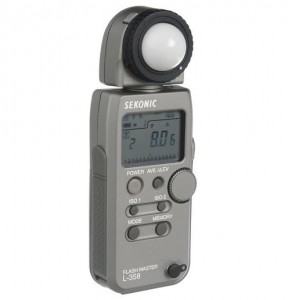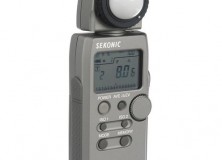 When I teach classes to new photographers, I have a “learn with what you already own” philosophy. I know how it is. You excitedly take your camera, bag and manual to the first class that will get you on the road to becoming a pro photographer and you’re suddenly faced with an excruciatingly long list of equipment you need with a grand total similar to the national debt. So, I try not to do that to beginners. But I do teach and mentor on an advanced level to photographers that desire to do studio lighting and involve themselves with advanced concepts – and when you get to that point, you just have to suck it up and start investing in some basic equipment. Enter the light meter.
When I teach classes to new photographers, I have a “learn with what you already own” philosophy. I know how it is. You excitedly take your camera, bag and manual to the first class that will get you on the road to becoming a pro photographer and you’re suddenly faced with an excruciatingly long list of equipment you need with a grand total similar to the national debt. So, I try not to do that to beginners. But I do teach and mentor on an advanced level to photographers that desire to do studio lighting and involve themselves with advanced concepts – and when you get to that point, you just have to suck it up and start investing in some basic equipment. Enter the light meter.
Those who know me, know that I have a “thing” for light meters. Those who mentor with me know that they must own and learn to use a light meter or I cannot mentor them. *sigh* yes, I am THAT person. The person that tells you that you can’t eyeball light. I don’t have tolerance for deviation from the ownership of a light meter. If you want to set up studio lights and keep fiddling with them until it looks right on the back of your camera, you go right ahead. Just don’t ask me for help. And please don’t teach a class in studio lighting, you’re only promoting bad habits.
I will admit that natural light specialists can probably get away with not owning one as long as they have learned how to use their in-camera light meter fully (as in, bust out that manual, baby, because you’re gonna be memorizing the section on the in-camera light meter) . But as far as studio lighting goes, a light meter is a must.
If you intend on learning ratios, and most of the mentorees I work with intend on learning this for the CPP exam – the exam and image submission REQUIRE 3:1 ratio images as part of the certification process – you cannot learn lighting ratios without a light meter. Yes, you can learn to calculate what the settings SHOULD be without one, but you can’t accurately adjust your studio lights to the proper ratios without a light meter.
There’s a huge difference between saying “A 3:1 ratio in studio photography can be accomplished by setting the main and fill with a 1 1/2 stop difference between them” and actually being able to set the lights correctly. Seriously, you can’t fake it, stop trying.
If nothing in this article made any sense at all – I recommend you pony up the money for a light meter (the one pictured is ~$309) and make that your next educational goal. No, the light meter is not the sexiest piece of equipment you will ever buy, but it will be one of the MAIN influences in the technical excellence of your images.

The same goes to me… I am always proud of/with myself carrying my L-358 at anytime…. and I just ordered myself NP 5 degree spot attachment….
AMEN
I was just teaching a class last night to some of our newer photographers, stressing the importance of the light meter. It's like going on a road trip without a map, sure it'll still be an adventure but you're going to be doing an awful lot of guessing along the way.